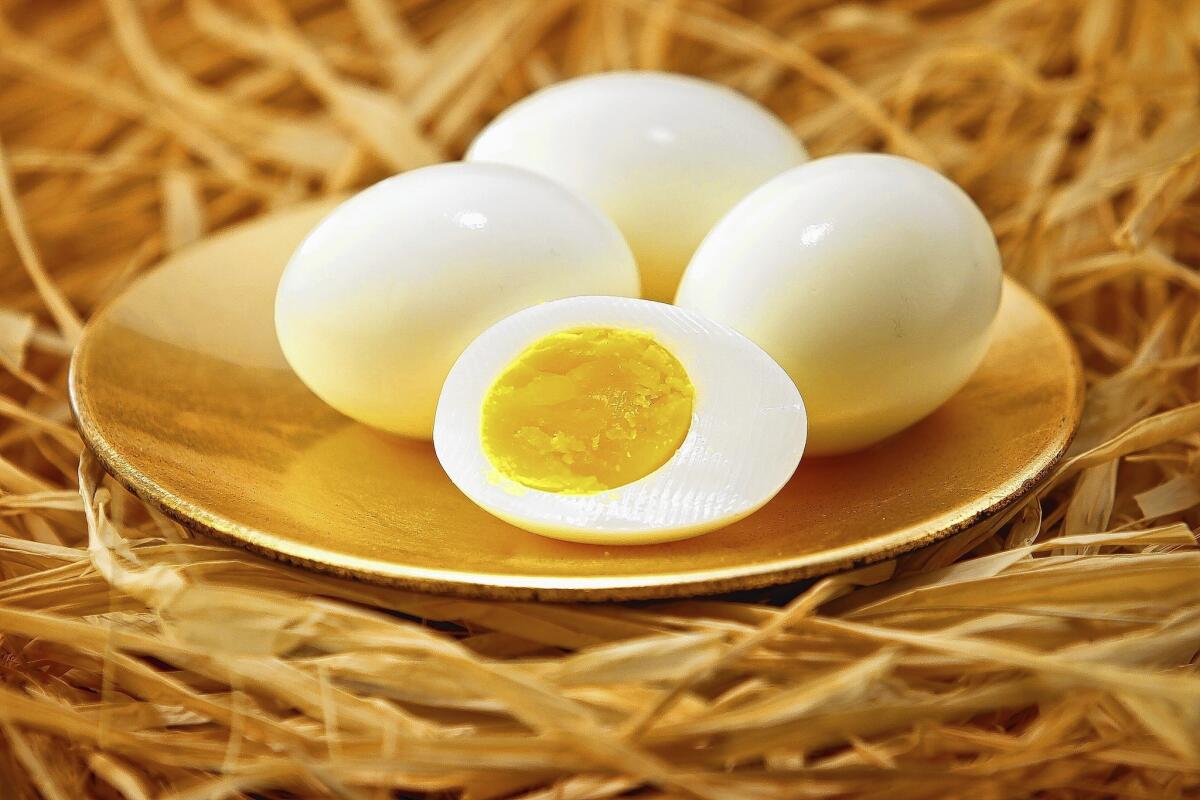California Cook: Hard-boiled eggs: OK, we tried it your way. But my way wins again.

- Share via
Call it the Great Easter Egg Smackdown of 2014. Every time I write about hard-boiled eggs, I seem to get a flood of mail telling me, essentially, “You’re an idiot, and you’re doing it all wrong.”
So this year I threw down the gauntlet. On our Daily Dish blog and on social media, I posted a challenge to all those hard-boiled naysayers: You tell me how you do it, and we’ll give it a try.
Not to get all smug, but my method won out again. Though I did pick up a couple of refinements along the way. (None of which is to say, however, that I am not an idiot; just that I can boil an egg.)
What makes the perfect hard-boiled egg? Our requirements are few but strict: The whites should be firm but creamy and not tough. The yolks should be completely set and orange (not yellow).
It should go without saying that any egg that turns up with a trace of green ring around the yolk is instantly disqualified with a sneer.
The weird thing, after all the flak I’ve taken, is that most of the people who sent in ideas this year actually recommended some slight variation of my technique (see accompanying article) — a little different timing, a covered pot, salted water … something like that.
Maybe the critics have given up on me. Or maybe they’ve listened to my pleas and given it a try, have seen the error of their ways and become converted. (I know, on the Internet? Well, it’s a dream.)
One technique we tried was suggested by a chef friend. He lowers the eggs into boiling water and cooks them for nine minutes exactly, then puts them into an ice bath. This was the second-best technique we tried, but the yolks turned out just a little underdone. They were orange, to be sure, but slightly runny.
Still, that was miles better than our experiment with baking the eggs, which was another suggestion that several people made. Our luck was not good: 13 minutes at 350 degrees, and we had what were pretty good over-easy eggs.
One thing I noticed about a lot of these suggestions: It seems like the simpler the task, the more specific and sometimes complicated the instructions.
One very good cook suggested a method that involved bringing water to a boil, taking the pot off the heat, adding the eggs and letting them sit for a few seconds off heat, then returning them to the heat and simmering them at a reduced temperature for 12 to 15 minutes, then plunging them into cold water.
That’s pretty convoluted (and also a bit vague on the crucial details (how low a simmer, for how long). In the hard-boiled egg world, there’s a big difference between 12 and 15 minutes). We went for the 15-minute mark and wound up with a green ring. Maybe our simmer was too high?
We also tried some variations on my technique. We tried cooking the eggs covered and uncovered, and in salted and unsalted water. Neither made any difference that we could detect.
The issue of timing was slightly more interesting. To try to find the exact right cooking time, we pulled sample eggs every 60 seconds between 10 and 15 minutes.
At the upper extreme, though the yolk seemed to keep the same texture, the whites did seem slightly tough. This makes sense. Because the whites contain pure protein with no fat, they are set at a lower temperature than the yolks. Though the eggs are cooking off the heat, the water was still in the 165- to 170-degree range; that’s enough to affect the whites but not the yolks. And at the lower extreme, the whites and yolk were slightly underdone.
It wasn’t enough that you would complain if you weren’t comparing side by side, but it was noticeable to us.
And to take home the crown in the Great Easter Egg Smackdown, that just wouldn’t do.
More to Read
Eat your way across L.A.
Get our weekly Tasting Notes newsletter for reviews, news and more.
You may occasionally receive promotional content from the Los Angeles Times.









